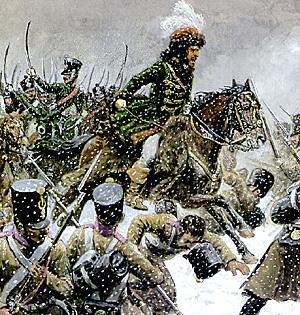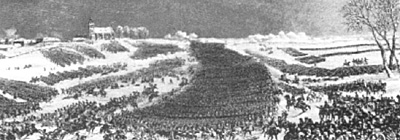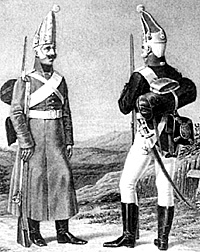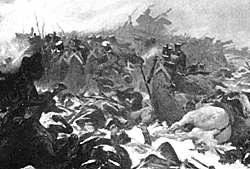 At the head of his 10,000 horsemen, ostrich feathers in his hat, Murat marshalled his 80 squadrons and led them into battle. The dragoons of Klein, Grouchy and Milhaud, and the
armored cuirassiers of d'Hautpoul; the rippling lines clattered forward in the snow with shouts of 'Close up! Close up!' echoing up and down the bobbing ranks.
At the head of his 10,000 horsemen, ostrich feathers in his hat, Murat marshalled his 80 squadrons and led them into battle. The dragoons of Klein, Grouchy and Milhaud, and the
armored cuirassiers of d'Hautpoul; the rippling lines clattered forward in the snow with shouts of 'Close up! Close up!' echoing up and down the bobbing ranks.
Rousselot's La Grande Charge D'Eylau
For a moment, the ghoulish rasping of metal on metal as the riders drew their long thrusting swords from iron scabbards. Then they were through the first bedraggled survivors of Augereau's two divisions, and broke into a canter. Murat, exultant, turned in the saddle when the foremost pursuing Russian horsemen appeared out of the snow-haze, and raised his sword-arm high: 'Charge, dragoons! Cuirassiers, charge!'
This tremendous force of Napoleonic Cavalry then sliced through the stunned and disordered Russian troopers, driving them back onto their infantry. Surprised, unprepared to receive cavalry, the Russian foot-soldiers were overwhelmed in a moment, even as they fumbled to level their muskets, Murat's Cavalry thundered on, its momentum hardly checked, and cannoned into the second line, a hundred yards or so to the rear. The veterans dived to hug the snow and let the torrent pass. The others loosed a ragged volley and were cut down where they stood. The second wave of cavalry bent low in the saddle to reach the great-coated figures lying sprawled in the snow before passing on to yet new targets. The third wave took whatever was left.
 Bennigsen looked on horrified. His first two lines had been cut to pieces and had it not been for his last reserve, the massed divisions of Samov and Dokhturov to the rear, his army would have been split clean in two. As it was, these battalions finally brought Murat's charge to a halt.
Bennigsen looked on horrified. His first two lines had been cut to pieces and had it not been for his last reserve, the massed divisions of Samov and Dokhturov to the rear, his army would have been split clean in two. As it was, these battalions finally brought Murat's charge to a halt.
Mass charge of almost 11,000 sabres at Eylau.
Their bloodlust sated and their energy spent, scattered troopers began to pick their way back through a path now littered with guns, corpses, and equipment, wounded horses and men. Officers rallied them into groups. Now, the Russians who had wisely let the irresistible mass pass over their heads rose to their feet, closed ranks, and began a ragged, but destructive, fire into the blown horses and riders.
Colonels realized that they were going to have to cut their way back to French lines. Grouchy was unhorsed, d'Hautpoul killed. More and more riders were toppled from their saddles. It seemed that everywhere that dead Russians were rising up again. The French tried to spur their tired horses, but it was useless. Murat fumed, leveled a pistol at a Russian officer who was pointing at him. "It's Murat, Murat my boys, our PRISONER!" The officer fell dead with a bullet in his head.
At the cemetery knoll, Napoleon could see what was happening. Murat would have to be cut loose.
"Bessieres, take the Chasseurs and Grenadiers a chevel and open a route for the Prince. The Guard cavalry moved off with Bessieres at their head, deployed, drew swords, and swept forwaard over snow already churned up by the passage of many horses. Murat was rescued, his divisions rallied. Over a thousand of his troopers lay stretched in the snow, new falls of which, like shrouds, were already covering up their bodies. But the crisis was past -- at least for the present.
 The Russian counterattack had been stopped dead in its tracks, although a single column, over 4,000 Russian Grenadiers, seemed oblivious to the ebb and flow of battle around it.
The Russian counterattack had been stopped dead in its tracks, although a single column, over 4,000 Russian Grenadiers, seemed oblivious to the ebb and flow of battle around it.
Russian Grenadiers
It marched steadily forward, and almost gained the walled cemetery at Eylau on its own. Pausing to dress ranks and within musket-shot of the Emperor, the foot-soldiers prepared to storm the village. Pale as a ghost, and visibly shaken, Napoleon nevertheless refused to budge.
Pavlov Grenadiers, 1807 © Musee de l'Armee, Paris
He ordered what remained of the Guard to attack the 'lost column' from all sides. His personal guard threw themselves at one flank of the isolated threatening mass: the Foot Grenadiers seized this chance to show the rest of the army what they were made of. Fixing bayonets and without pausing to return the point-blank musketry they received in the face, they charged and broke the Russians at the run.
 Augereau's 14th Regiment had rallied, formed square, and waited on for further orders. Messengers sent to recall were killed and the men became isolated. By the time the order to withdraw reached them, they were shot to pieces and trapped by the Russians.
Augereau's 14th Regiment had rallied, formed square, and waited on for further orders. Messengers sent to recall were killed and the men became isolated. By the time the order to withdraw reached them, they were shot to pieces and trapped by the Russians.
The Fourteenth of the Line at Eylau by F. Cormon (1890's)
More Eylau
-
Introduction
10am
Charge of Murat
12 Noon
11pm
Eylau Order of Battle
Eylau Map Large (very slow: 245K)
Eylau Map Jumbo (extremely slow: 406K)
Back to Age of Napoleon 29 Table of Contents
Back to Age of Napoleon List of Issues
Back to MagWeb Master List of Magazines
© Copyright 1998 by Partizan Press.
This article appears in MagWeb (Magazine Web) on the Internet World Wide Web.
Other military history articles and gaming articles are available at http://www.magweb.com